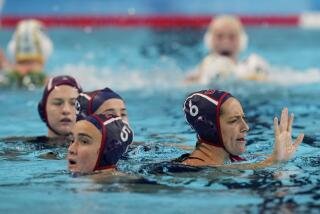U.S. Team Witnesses First Volleys of a Revolution in China
- Share via
On the first day of a nine-day tour to China last week, the U.S. women’s national volleyball team walked into history.
After a lengthy flight from San Francisco to Shanghai to Beijing, the 21-person entourage departed for their hotel in the capitol city at 4 a.m. In the early morning hours, however, they were delayed about a dozen times at makeshift blockades in which students bedecked with red head bands were checking vehicles coming into Beijing.
Without official escorts, the volleyball team was on its own. And when examing their luggage, U.S. Coach Terry Liskevych said, the students thought it contained tear gas canisters to be used by the Red Army against demonstrators. They wanted to confiscate all baggage.
But once they understood through a U.S. interpreter that the luggage contained nothing more lethal than volleyballs and uniforms, they still wanted the baggage with USA Volleyball stencilled on the front.
“They wanted to use them as part of their barricades,” Liskevych said in a telephone interview from Beijing early Sunday morning. “Once they knew who we were a big cheer would go up at each checkpoint as they let us through.”
Liskevych, who coached the 1988 Olympic team, scheduled the tour so his team could compete in two tournaments against some of the world’s best teams--China, Cuba and Japan. Although Cuba is regarded as the world’s top-ranked team, the U.S. coaches were interested in gaining first-hand knowledge of how the Chinese have maintained their high-ranking status. China, the 1984 gold medal winner by beating the U.S. in the final, was ranked No. 1 in the world from 1980 to 1987, Liskevych said. China won the bronze medal at the Seoul Olympics last summer.
But the students’ siege that began at Tian An Men Square, the ceremonial center of the country, has turned the tour into a political and cultural adventure. The square has been occupied for the past 16 days by thousands of students who have stayed after a one-week hunger strike and have so far resisted government pressure to disperse. Defying martial law and the threat of army intervention, the students have demanded the resignation of Premier Li Peng and a crackdown against government corruption.
After the tumultuous day in Beijing, the U.S. team traveled to Chengtu in the Szechwan provence southwest of the capitol, where they finished last in a tournament.
Liskevych said peaceful demonstrations also were occurring in Chengtu where several thousand students were lingering around a statue of Mao Tse-tung, deceased chairman of the Communist Party.
He said interest in the events at Beijing have captivated the country. In their first match against China, the Chinese did not warm up because they were too busy watching television monitors of the students at Tian An Men Square.
The Chinese did not need the extra practice. They won, 3-0.
Some U.S. students in China drove eight hours to watch the team, but were told all tickets had been sold. A man approached the disappointed students and offered them tickets for three times face value. After buying the tickets, the students told U.S. team members that the scalper shared his earnings with the ticket vendors.
The tour returned to Beijing, where the four countries played to sparse crowds over the weekend. The United States was third, beating Japan.
“In all the times we’ve played in China we’ve never had a non-sellout,” said Liskevych, whose team has played eight matches in China in the past two years. “We played before less than 1,000 in a 19,000-seat arena.”
He said Saturday night’s final pitting Cuba against China drew only 11,000.
“There was a lot of apprehension,” Liskevych said. “People were afraid to leave their homes for fear of not being able to return because of more blockades.”
Though the Americans were warned to stay away from the city’s center, they asked their Chinese bus driver to take them to the square, which is just outside the Forbidden City. He gladly complied but could get no closer than a few blocks from the demonstrators.
“A lot of students with flags barricaded it off,” Liskevych said. “It was fascinating to see all of this. The players took this all very well. They are a veteran team. They roll with the punches. They are very excited to have this going on while they’re here.”
Entering volatile situations is not a first for the volleyball team. In 1982, a heavily favored U.S. team lost in the semifinals of the World Championships when they faced a vociferous anti-American crowd in a match against Peru at Lima. They became unnerved and lost in a scenario similar to the U.S. Davis Cup team’s upset at Paraguay in March, 1987.
Last year, the team witnessed student riots on the streets of Seoul at pre-Olympic competitions.
“It’s part of international play,” Liskevych said.
The women will return to their San Diego-based training center today where they will have time to refine their volleyball skills as well as recount another historical moment.
More to Read
Go beyond the scoreboard
Get the latest on L.A.'s teams in the daily Sports Report newsletter.
You may occasionally receive promotional content from the Los Angeles Times.






